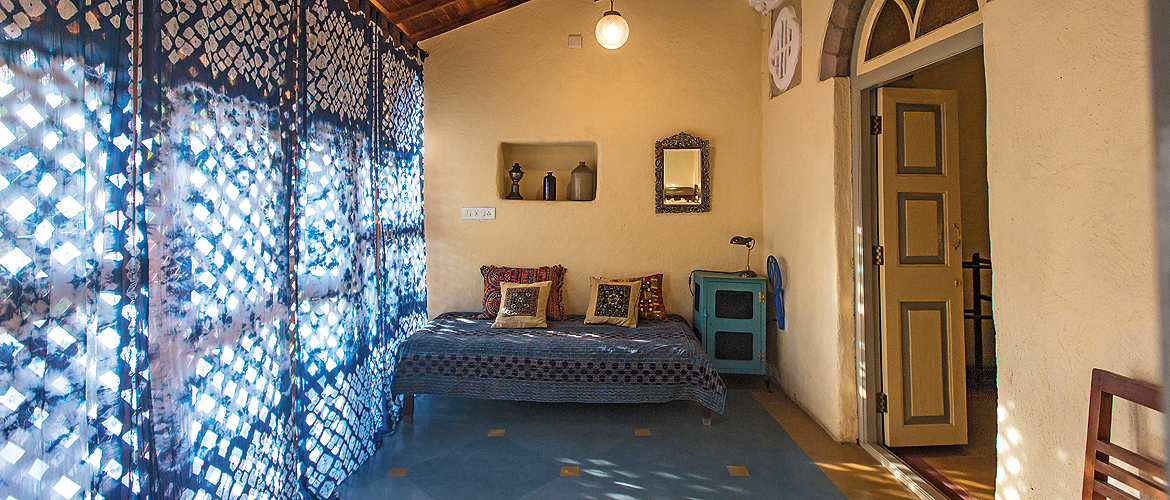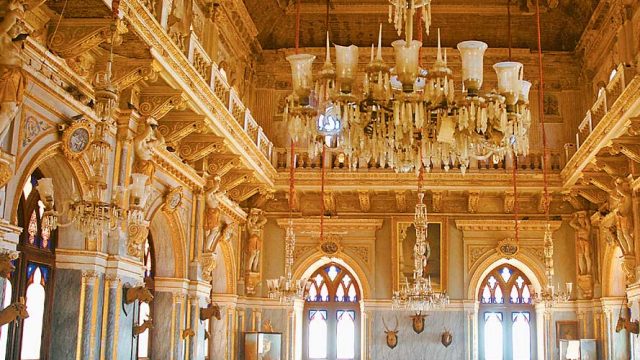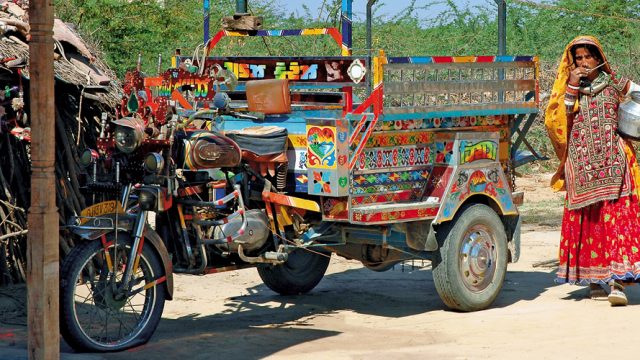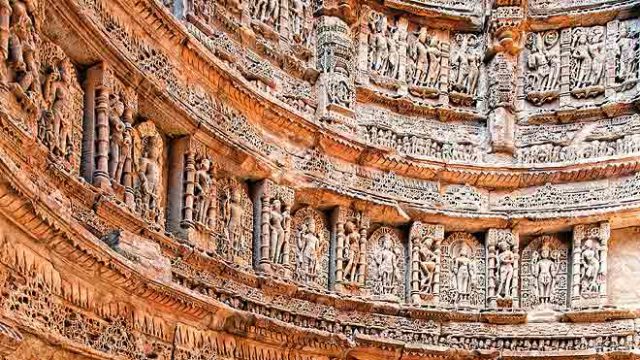It must have been sometime in the early-to-mid twentieth century when Faradoon Pestonji Bhuj- wala had already
This story of how Faradoon spent the dusk of life is just another page in the century-and-a-half old history of this house. But for each of the six generations it has housed, such anecdotes have added to a strong sense of belonging.

Today, just like decades ago, the hichka room is accessed immediately upon entering. Except, this ancestral home has, since October 2015, been rechristened and revamped into the posh-yet-very homey Parsi-style homestay called The Bhuj House, located in Bhuj’s Camp Area in Gujarat’s Kutch district. It’s easy to spot—stop in front of a sand-themed front façade with a jafri or latticework screen surrounding it and a red-tiled slanting roof above it. If they are there, you will be greeted by Jehan Bhujwala and his wife, Katie, the current generation responsible for making it into a homestay, or else, the equally hospitable Khurshed, the manager.

But the roots can be traced to Sorabji Dadabhoy. If he hadn’t migrated to the town in the 19th century, his son and Faradoon’s father, Pestonji Sorabji Bhujwala, wouldn’t have built this ancestral home and it wouldn’t have become the massive courtyard house it is today. In fact, of the 20 Parsi families who joined Sorabji to inhabit the Camp Area, the houses of only two remain standing, and only this one remains in use. Pestonji’s great-grandson, the namesake Pestonji Ardeshir Bhujwala, is to thank for that. If the latter hadn’t spent his initial years here before moving to Mumbai, he would not have become so attached to the place. The ancestral home was his childhood. His son, Jehan, grew up with the exact same sentiment.
Everything here stands frozen in time—the hichka room has an at least 60-year-old HMV gramophone with an accompanying vinyl collection, a table with an ancient telephone, old glass lamps and the portrait of the mustachioed first Pestonji with his Parsi cap on. The adjoining sitting room has many such artefacts too, such as an ancient Remington Portable Model V typewriter.

We stayed in Rohee’s Room, which has a story of its own. Cousin Rohee was its last occupant and one of the last Parsis to move from Bhuj. For me, this room symbolised the migration of the community away from the town, the same town that once housed many families and where the first Pestonji earned the maharao or maharaja’s camaraderie made a fortune manufacturing liquor. He even founded an agiary or fire temple, which is one of the three Parsi buildings left in the area.

But history isn’t all there is to the room. It is luxurious and has a spacious bathroom, and a few features that stand out—spellbinding Kutchi craftworks and fabrics constitute most of the room’s furnishings, paintings showcase old scenes from Kutch and a small room, with another bed and a desk, is connected to the main room, making it a vintage suite. The other three rooms have similar features. Agassi Room has two twin rooms next to each other and underneath a sloped roof on the first floor. Nano Room is small only if you compare it to the other rooms. The Jafri Room, which has a similar jafri as the front façade, has been converted into a room from a toilet! Back in the day, attached toilets weren’t really the convention.

At The Bhuj House, the courtyard became our favourite place to relax and socialise. The Bhujwalas are great company; we had a lot of engaging mealtime conversations with them here. Children, especially, adore this space. Jehan and Katie’s 12-year-old son is often immersed in his football magazines and keeps a lookout for foreign tourists from his favourite football-playing nations, while their 9-year-old daughter has an amusing way of carrying the younger pet cat, Chintu, all the way up the stairway leading to the Agassi Room—on her back.

The outdoor common dining area is attached to a 24-hour open pantry. And there’s the amazing home-cooked Parsi and Kutchi food prepared by Sant Kumar, the chef, who was taught by Khurshed. The highlights were the lovely Parsi tea (tea with lemongrass and mint) in the evenings and the amazing Parsi dishes during the meals, including the perfectly seasoned mutton dhansak (sweet and sour, the one here is cooked using masalas made by Khurshed’s mother), the refreshing egg bhindi (sunny side up with okra), akhuri (a breakfast favourite; same preparation as scrambled egg), the flavourful macchi ka patya (fish in tomato-based gravy) and finally, my favourite, the egg-batter fried chicken farcha (marinated creamy fried chicken).

Open from all sides, the courtyard is sun fed all day. One can sit on the bench and admire the white bougainvillea flowers. A contrast to the overall vintage theme, the many ornaments and garden plants here are very contemporary and chic. The pantry kitchen has a similar character—an ancient meat safe (though, not used to store meat) and many antique kettles and utensils are in the same space as a modern kitchen setup.
When I first asked Khurshed about the places we should see in Bhuj, he recommended an elaborate exploration of the many craft centres and villages. I was a little confused initially, expecting the usual recommendations such as Aina Mahal, Prag Mahal and the Great Rann, but after a visit to the villages, I couldn’t have been more grateful.
I soon realised that these traditional crafts and The Bhuj House had a glaring similarity—during the 2001 earthquake, the ancestral home had suffered great damage, but the family used this destruction as an opportunity to give it a new lease of life. Over the next nine years or so, the house was rebuilt one step at a time. Similarly, crafts too lost out a lot during the earthquake. But did the craftspeople put down their tools? No. They decided to take their art forward.
We first visited Bhujodi village, which is a major weaving hub about 8km from Bhuj. We visited the workshop of the national award-winning craftsman, Vankar Vishram Valji, and immediately spotted colourful textiles of all designs and kinds, be it shawls, stoles, saris or scarfs. There I met his son, Vankar Dinesh, who told us both hands and both feet are used in conjunction while weaving. While the feet are used to hit the pedal, which either lifts or lowers a bunch of threads to create the pattern, the hands are used to throw the shuttles, facilitating the weaving itself.
Similarly, there’s ajrakh or block printing that takes place in the village of Ajrakhpur. We visited Ismail Mohamed Khatri’s workshop, where block printing is done using natural colours. His sons, Junaid and Sufiyan, have taken the art to such heights that they’ll be showcasing their own collection during the Lakme Fashion Week 2017. Even while we were there, their affluent clientele from all over surrounded us.
While block printing itself is a simple process, where a block is dipped in colour and pressed on a cloth, dyeing is complicated. First, alum is applied to the part they want dyed and then the fabric is dipped in colour. Once it dries, the cloth is cleaned and the beautiful design is revealed. But perhaps the most fascinating craft is tie and dye, locally known as bandhani. Khatri Alimohamed Isha practices this art in Bhuj. He showed us how one first takes and marks a cloth, and then at each point that is marked, ties a thread. This is then dipped in bleach and dyed in colour and then dried. Then, one proceeds to stretch the cloth for the threads to pop out. The result is the creation of a gorgeously textured cloth.
We also visited the Living and Learning Design Center (LLDC) by the NGO Shrujan, where the embroidery done by many different local communities is displayed. The museum attempts to introduce people to their cultures.

Evenings and mornings were mostly spent at The Bhuj House, and afternoons understanding the many crafts. We spent one late afternoon at the shipbuilding centre of Mandvi. Staring at a massive 13,000-tonne wooden ship being built by combining millions of planks was a fascinating experiencing. We spoke to Shivji Bhuda Fofandy, a ship maker par excellence, whose Sagar Ship Museum housed a few fantastically crafted ship models, including one inspired by Pirates of the Caribbean. But, I’m not sure he had many takers. Immediately, I connected it with the rest of what this trip had offered me—crafts constantly striving for recognition and a gem of a property that not too many know of.
The Information
Getting There
Bhuj has an airport, but direct flights only go from Mumbai (from approx ₹6,000 one way). A train to Bhuj station is more convenient. Ala Hazrat Express (14321/14311; ₹1,990– ₹2,115 one way) takes 22-26hrs from Delhi and is a cheap option. Kutch Express and Dadar Bhuj Express are two more trains that connect Bhuj to Mumbai.
The Bhuj House
Of its four rooms, Rohee’s, Jafri and Agassi begin at ₹5,600 a night for two and Nano at ₹4,600; ₹1,500 per extra bed, taxes and breakfast included. CONTACT: +91-9098187346, +91-2832-223426. For details, see thebhujhouse.com.
What to Eat
There’s delicious Parsi and Kutchi food cooked at The Bhuj House. But if you’re in a mood for some great Gujarati, the Special Toral Thali at Prince Restaurant is only for ₹250 and shouldn’t be missed. Khurshed gives a well-researched street food tour as well.
What to See & Do
Visit as many of the local craft villages and centres as you can. Kutch is known for six crafts—bandhani, ajrakh, weaving, embroidery, batik and patchwork/appliqué.
Visit the LLDC museum for an insight into local embroidery work.
Nirona village has some unique arts—leatherwork, a copper-bell maker, lacquer work and traditional rogan work.
Visit Mandvi and see the Sagar Ship Museum. Also, ask and enter some of the ships being built.
Visit the historical Bhujia Fort, where you can get a 360° view of the town. You could take a heritage walk across the city and explore Prag Mahal and Aina Mahal and other well-known attractions. Additionally, there’s always the option to visit the Great Rann of Kutch.
A visit to Dholavira, an old Indus valley site, is worth considering.
Great Rann of Kutch
Gujarat
homestay





